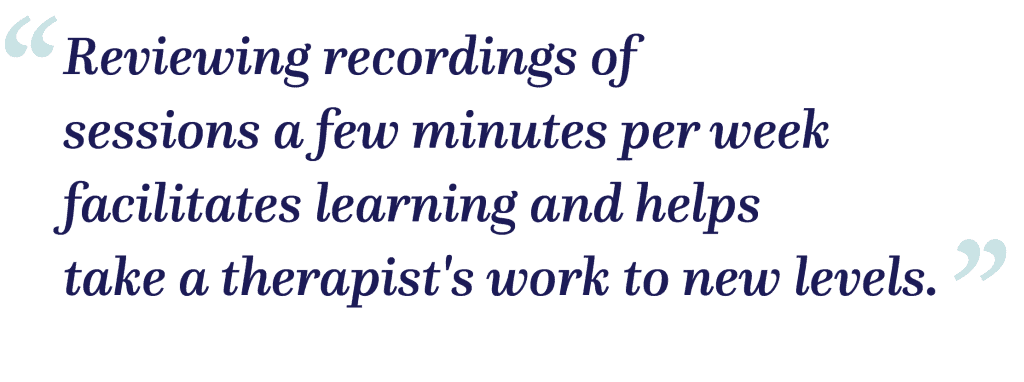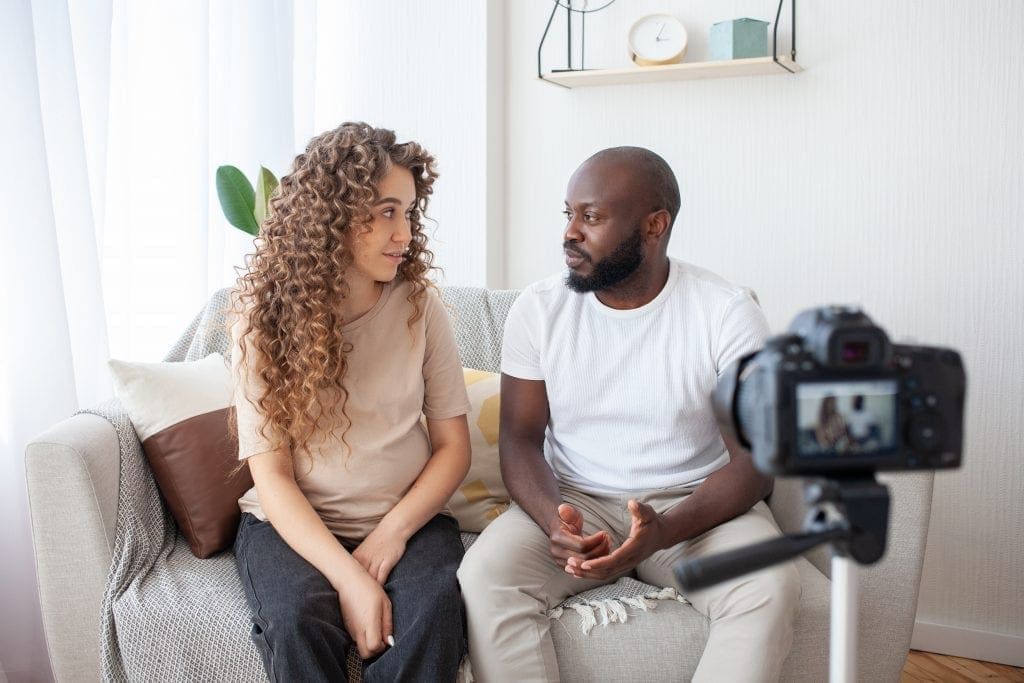Training in the PACT model sparks excitement for clinicians. It also presents a steep learning curve. Even seasoned therapists experience some uncertainty when learning such an active and complex approach. PACT challenges therapists to integrate multiple components and theories into a sophisticated model. The full integration, while quite satisfying, takes time, patience, and practice.
 As with any new skill or approach, the process feels less daunting when therapists incorporate deliberate practice techniques into their learning. One of those techniques and a key element in PACT, videotaping sessions, aids clinicians in honing their PACT proficiencies. Reviewing recordings of sessions a few minutes per week facilitates learning and helps take a therapist’s work to new levels.
As with any new skill or approach, the process feels less daunting when therapists incorporate deliberate practice techniques into their learning. One of those techniques and a key element in PACT, videotaping sessions, aids clinicians in honing their PACT proficiencies. Reviewing recordings of sessions a few minutes per week facilitates learning and helps take a therapist’s work to new levels.
In this post, I outline some of the advantages of the technique and share tools to help newcomers increase their comfort and confidence in incorporating the process into their practice.
Despite the vast benefits of recording sessions, many therapists balk at implementing this technique. Until I began using it, the thought of voluntarily recording and watching my own work sounded like a special kind of self-inflicted torture. Every aspect of the process, from broaching the subject with clients to choosing the technology and securing recordings prompted questions and insecurity. However, once implemented, the long-term benefits of recording sessions greatly outweighed any initial awkwardness.
Fast forward eight years, I now mentor and train other therapists on best practices for using video recording in psychotherapy.
Some therapists find addressing the subject with clients the most difficult hurdle in implementing recording. Early on, I felt as though I was asking clients for a favor, rather than describing a valuable aspect of my approach to therapy. As a result, I sounded insecure and uncertain. Client responses reflected my discomfort.
Now my communication with clients clearly conveys my view of recording as an indispensable part of my practice, particularly when I need help with difficult cases or when I feel lost in the weeds. Based on my experience, I recommend several techniques to other therapists who want to build their confidence in this area.
Start by writing down the benefits of recording sessions. These are well-documented in the literature and include
increased affect-tolerance
increased insight and self-awareness
identifying countertransference
recognizing verbal tics, cues, or other signs of anxiety
Use this list to practice outlining the benefits clearly and succinctly until it feels comfortable. As a therapist, you may have additional goals based on your own learning edge. Recruit friends and colleagues to help rehearse and give feedback. The ultimate goal is to deliver a brief explanation of the video recording practice in a manner that provides information and conveys confidence.
Prepare for a variety of questions and concerns from clients only after reaching a level of comfort in explaining the purpose of the technique. In my experience, the discussion becomes much easier after the first few conversations with clients.
In my initial consultation with a couple, I address video recording sessions as part of my description of my therapeutic approach. I typically say, “As part of my commitment to quality treatment and improving my work as a therapist, I record sessions with my clients´ consent.”
I then provide a quick overview of how recording helps me and benefits my clients, how I keep recordings secure, and that they can change their minds at any time. I emphasize that although their decision regarding recording will not impact our therapeutic alliance, it will likely help me better serve them. I then ask if they have any questions or concerns about recording and encourage them to discuss it at home before making a decision.
I encourage regularly recording sessions because the footage allows a therapist to review specific details of a challenging session, assess the impact of interventions, and consider alternatives. During one particularly difficult session with a couple — let’s call them Edward and Michael — Edward’s intense threat response to an ostensibly benign comment from Michael took me off guard. The session seemed to escalate quickly from that moment, with both partners resistant to my efforts to help them return to a state of equilibrium. Neither could articulate what had occurred between them. They appeared as befuddled by the interaction and rapid escalation as I. This session left me feeling confused and ineffectual as a therapist.
When I reviewed the recording of the session later, I slowed down the tape beginning several minutes before things escalated. At the slower speed, I was able to take in the precise details, the nuanced expressions and responses that I had missed in real-time. About 90 seconds before the start of the rapid decline in the session, I saw Michael swallow several times, indicating a dry mouth and a possible rise in sympathetic activity. Going back a few more seconds, I saw Edward lift one corner of his mouth in an ever-so-slight smirk. As I watched the rest of the interaction play out, I caught the minute rise of Edward’s chin at the tail end of his comment.
In this context, the indication of contempt followed by aggression, Edward’s comment appeared much less benign and Michael’s threat response made more sense. Seeing this play out in slow motion provided new insight into the couple’s interactions. Equipped with this information, I prepared for my next session with Edward and Michael and considered options for interventions should they repeat this dynamic.
In PACT, the use of video recording becomes an intervention in and of itself. Used carefully and in the right moment, replaying even a few seconds of an interaction for a couple gives partners a completely new perspective on their habituated responses. The camera offers a (more) objective view of facial expressions and threat responses. Therapists use this technique to provide partners with an often-elusive opportunity for insight and awareness.
In a subsequent session when Edward smirked and Michael reacted, I paused them and pointed out the exchange. Edward, oblivious to the look on his face wondered at Michael’s reaction. Michael identified a comment from Edward rather than a look on Edward’s face as the source of his threat response. Michael said he had not seen the look and expressed confusion as to the intensity of his own response. I stopped recording the session and played that portion back for the couple. Edward showed surprise at the look of contempt on his face while Michael said he felt validated. We then explored more deeply the source and impact of contempt in their relationship.
 If watching the session recording on my own had not provided the information I needed, my next step would have been to use the recording to seek consultation from another PACT therapist. By using a video recording, I have confidence that my colleague sees the most accurate depiction of what occurred and gives me feedback accordingly. To seek peer consultation without a recording requires relying on my faulty memory of what took place. When the consultation relates to a challenging session my countertransference invariably colors my recall, just as it likely impacted my effectiveness in session.
If watching the session recording on my own had not provided the information I needed, my next step would have been to use the recording to seek consultation from another PACT therapist. By using a video recording, I have confidence that my colleague sees the most accurate depiction of what occurred and gives me feedback accordingly. To seek peer consultation without a recording requires relying on my faulty memory of what took place. When the consultation relates to a challenging session my countertransference invariably colors my recall, just as it likely impacted my effectiveness in session.
Having a circle of colleagues who also record sessions and establishing guidelines for providing feedback creates a safe environment for vulnerability in mutual peer supervision. I have several colleagues with whom I regularly take turns reviewing sessions. In this supportive exchange, we encourage each other as well as identify and work on areas for growth. We find monitoring and regulating arousal level while watching and pausing a few minutes of high conflict or otherwise difficult sessions greatly improves our affect tolerance and ability to manage countertransference. This type of peer consultation requires a high level of commitment and a willingness to self-disclose and provides a profound degree of growth for therapists.
In addition to receiving consultation from colleagues, the use of video allows me to provide better consultation to other therapists involved in the couple system. Therapists working individually with either partner can achieve valuable insight into their clients’ relationship dynamics by watching part or all of a session. This is particularly true when clients have demonized their partners to their individual therapists. As an individual therapist, I’ve worked more effectively with clients after gaining a more balanced view of my clients’ relationships.
In some eight years since I recorded my first psychotherapy session, the camera has come to symbolize my observing self in the room. Although I’m not consciously aware of it, I know I am a better therapist when the camera is rolling. I’m more focused, more mindful, and more intentional in my work. Other therapists who record sessions have shared similar experiences with me.
My camera has been my partner in my journey on the learning curve of the PACT model. I continue to use it to increase confidence and proficiency as I integrate new techniques and interventions into my work. Given that I evident that I’ve also become somewhat evangelic on the topic of using video recording as part of clinical practice. I actively encourage you to take the leap if you haven’t already.
This article is slated for the February 2021 PACT Institute newsletter. Although it focuses on the use of video recording in PACT couple therapy, I use the technique in my work with individuals as well.


Thanks!
Hi, do you mind sharing what equipment you are using? I am inspired to begin recording video and audio of my sessions and do not know where to begin in terms of recommended equipment.
Hi Shayla, I periodically offer online seminars on deliberate practice for therapists and incorporating video recording into your clinical practice. If you’re interested, you can subscribe to the mailing list at traumawisetherapy.com. I promise not to spam you! I’m currently using a regular camcorder, but in the next month or two, I plan to purchase a Panasonic camcorder with dual lens. https://www.bhphotovideo.com/c/product/1383053-REG/panasonic_hc_wxf1k_hc_wxf1_4k_camcorder.html/?ap=y&ap=y&smp=ba_f1_lar&smp=y&lsft=BI%3A6879&gclid=CjwKCAjw_MqgBhAGEiwAnYOAemLGfyOl3r7cwSAH2PULTbuWRyPalROL2J4h4fxdyIzmrEsDy2eh8hoCjQUQAvD_BwE